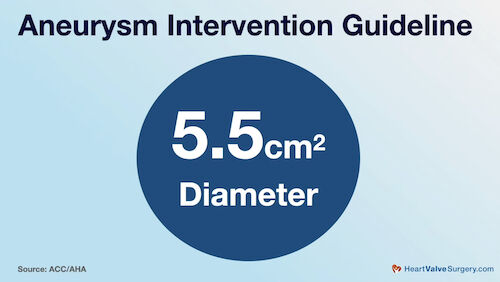Surgeon Q&A: What Are Annual Growth Rates for Aortic Aneurysms?
Written By: Allison DeMajistre, BSN, RN, CCRN
Medical Expert: Chris Malaisrie, MD, Professor of Surgery, Co-Director Bicuspid Aortic Valve and Thoracic Aortic Surgery Program, Northwestern Medicine
Reviewed By: Adam Pick, Patient Advocate, Author & Website Founder
Published: September 4, 2024
The enlargement of the first section of the aorta, where the aortic valve sits, is called an aortic root aneurysm. A dilated aortic root can cause life-threatening situations if the aneurysm tears, dissects, or ruptures. In many cases, the aneurysm is small, asymptomatic, requires no intervention and is managed with careful monitoring, medications, and lifestyle modifications. Still, it’s an unsettling diagnosis, so it’s essential to understand the implications of the aortic root size and growth rate and when it’s time for surgical intervention.
We recently received a patient question from DB on the topic of aortic root enlargement. DB asked, “Are there any studies regarding statistical values of growth per year for an aortic root?” We met with Dr. Chris Malaisrie during the annual meeting of The Society of Thoracic Surgeons, who was kind enough to answer DB’s question. Dr. Malaisrie is a leading aortic valve and aneurysm specialist at Northwestern Medicine in Chicago, Illinois.
Key Learnings About Yearly Growth Rates of Aortic Root Aneurysms
Here are the important insights shared by Dr. Malaisrie:
- Medical teams should follow aortic root aneurysms very closely. Malaisrie stated, “We do have those values, and we follow a lot of small aneurysms that don’t need surgery. We follow them very, very closely, so yearly scans, sometimes six-month scans. We notice that the average annual growth for aneurysms is somewhere between 0.5 millimeters and 1.5 millimeters, so the take-home number is about one millimeter per year. It also depends on how big the aneurysm is. The bigger the aneurysm, the faster it grows.”

- The current guidelines for intervention can vary by patient. “Aneurysms, the bigger they get, the higher the risk of aortic dissection, ruptures, or aortic catastrophes,” said Dr. Malaisrie. “Right now, we don’t like aneurysms to get over 5.5 centimeters, sometimes 4.5 centimeters, depending on patient comorbidities, specific imaging characteristics, and factors associated with that particular patient. It’s important to talk to your doctor about when you need aortic surgery for an aortic aneurysm.
Thank you Dr. Malaisrie and Northwestern Medicine!
On behalf of DB and all the patients in our community, many thanks to Dr. Malaisrie and the entire team at Northwestern Medicine for taking such great care of heart valve and aneurysm patients.
- No More “Walking Time Bomb” for Tom After Valve-Sparing Aortic Root Replacement
- SAVR or TAVR: Jim Whitney & Dr. Chris Malaisrie Explain Their Choice
- See 50+ Patient Reviews for Dr. Chris Malaisrie
Keep on tickin!
Adam
Video Transcript:
Adam: Hi, everybody. It’s Adam with heartvalvesurgery.com. We’re in San Antonio, Texas at the annual meeting of The Society of Thoracic Surgeons. I am thrilled to be joined by Dr. Chris Malaisrie who’s a leading aortic valve and aneurysm specialist at Northwestern Medicine in Chicago, Illinois. Dr. Malaisrie, it is great to see you again. Thanks for being with me.
Dr. Malaisrie: Thank you very much, Adam.
Adam: Yeah, so we’re here at this meeting. We’re learning a lot. We got some patient questions coming in for you. The first one comes in from DB. DB asks, “Are there any studies regarding statistical values of growth per year for an aortic root?”
Dr. Malaisrie: We do have those numbers and we follow a lot of aneurysms that are small that don’t need surgery. We follow them very, very closely, so yearly scan, sometimes six months scan. We notice that average yearly growth for aneurysms is somewhere between 0.5 millimeters to 1.5 millimeters so take-home number is about a millimeter per year. It also depends on how big the aneurysm is. The bigger the aneurysm, the faster they grow.
Adam: Dr. Malaisrie, a quick follow-up is at that point where you’re going to intervene on an aneurysm, what are the current guidelines for a patient who is monitoring their aortic aneurysm progression?
Dr. Malaisrie: Aneurysms, the bigger they get, the higher the risk of aortic dissection or ruptures, so aortic catastrophes. Right now, the top number, we don’t like aneurysms to get over this number, is 5.5 centimeters. We slowly revise that number down to 5 centimeters, sometimes 4.5 centimeters depending on patient’s comorbidities, specific imaging characteristics and factors that are associated with that particular patient. It’s important to talk to your doctor about when you need aortic surgery for an aortic aneurysm.
Adam: DB, I hope that helped you. I know it helped. Dr. Malaisrie, on behalf of all the patients in our community, thanks so much for everything you’re doing at Northwestern Medicine.
Dr. Malaisrie: Thank you very much.
Adam: Hi, everybody. It’s Adam. I hope you enjoyed that video. Don’t forget you could always subscribe to our YouTube channel, watch the next two educational videos coming up on your screen, or click the blue button to visit heartvalvesurgery.com.




